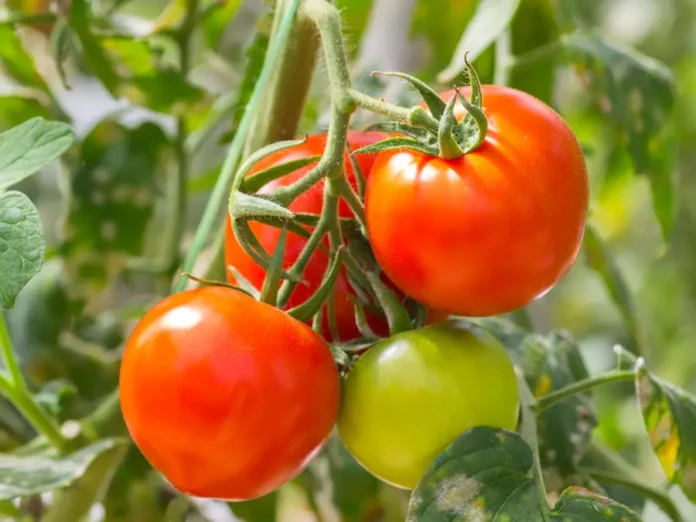Powdery mildew is a common fungal disease that severely affects tomato plants, especially in controlled environments like greenhouses and high tunnels. This disease can cause yield losses of 10% to 90%, depending on the severity of the infection. Powdery mildew is caused by fungal species like Oidium neolycopersicum, Leveillula taurica, and Erysiphe orontii. It was first identified in France in the 1840s and has since spread to various parts of the world.
Type and Mode of Infestation
Powdery mildew is a fungal disease that typically affects tomato leaves. The fungi spread via spores, which are easily carried long distances by wind and air currents. Once the spores land on tomato plants, they begin to infect the leaves, resulting in significant damage to the plant’s photosynthetic capacity.
- Disease Category: Fungal
- Most Affected Plant Part: Leaves
- Spread Mechanism: Wind-borne spores
Environmental Factors Favoring Disease Development
Several environmental factors contribute to the development and spread of powdery mildew. The optimum temperature range for the disease to thrive is between 60°C to 80°C, coupled with a relative humidity (RH) above 90%. The high humidity, especially in regions like Maharashtra, Karnataka, Tamil Nadu, Kerala, and West Bengal, provides ideal conditions for powdery mildew outbreaks.
- Temperature Range: 60°C to 80°C
- Optimum Relative Humidity: Above 90%
- Most Affected States in India: Maharashtra, Karnataka, Tamil Nadu, Kerala, West Bengal
Symptoms of Powdery Mildew in Tomatoes
The first sign of powdery mildew in tomatoes is the appearance of irregular bright yellow blotches on infected leaves. The upper surfaces of the leaves develop a white powdery growth, while the lower surfaces show chlorotic spots. As the disease progresses, the leaves begin to wither and die. In severe cases, this defoliation can lead to sunburn on the tomato fruits, reduced soluble solids in the tomatoes, and a weakened plant structure. If left untreated, powdery mildew can cause complete plant death.
- Initial Symptoms: Yellow blotches on leaves, white sporulation on upper leaf surface, chlorotic spots on the lower surface
- Severe Symptoms: Premature leaf death, sunburn on fruits, weakened plants, potential complete plant death
Biological Control Measures for Powdery Mildew in Tomato
Several organic and biological products are available to manage powdery mildew in tomato crops. These products provide a sustainable, eco-friendly alternative to chemical fungicides while enhancing plant health and soil fertility.
Zymo Biologique
Zymo Biologique is a powder-based product containing organominerals, macronutrients, and stabilizers. It acts as a broad-spectrum organic mineral fungal control agent. By improving soil fertility and incorporating bio-organic extracts and natural minerals, Zymo Biologique helps suppress fungal activity in the tomato crop. This product is widely recommended for controlling powdery mildew in organic farming systems.
Xymo Max Spread
Xymo Max Spread is a liquid biopesticide designed to enhance the spread of the treatment solution across the plant surface. This product reduces the surface tension of water, ensuring uniform coverage of the biopesticide on all parts of the tomato plant. Xymo Max Spread can be used on a variety of crops, including tomatoes, and improves the efficacy of fungal control agents.
Xymo BLT100
Xymo BLT100 is another powder-based biopesticide that contains non-GMO biologicals, lysing biocatalysts, stabilizers, and bioenhancers. It is recommended for managing not only powdery mildew but also other fungal diseases like early blight, late blight, and Septoria leaf spot. The broad-spectrum nature of Xymo BLT100 makes it a versatile solution for managing multiple diseases in tomato plants.
Merlyn Nutrix
Merlyn Nutrix is a micronutrient-rich product that enhances overall plant growth and development. Available in liquid form, Merlyn Nutrix contains magnesium ions that aid in chlorophyll formation, which is essential for photosynthesis. This product is effective against powdery mildew, improving the physiological response of the plant and reducing the severity of disease symptoms.
- Zymo Biologique: Powder form, organominerals and macronutrients, improves soil fertility, controls plant fungus
- Xymo Max Spread: Liquid form, enhances biopesticide coverage, reduces surface tension for better spreading
- Xymo BLT100: Powder form, broad-spectrum bio-agent, controls early blight, late blight, Septoria leaf spot
- Merlyn Nutrix: Liquid form, micronutrient-rich, boosts plant metabolism and photosynthesis, fights powdery mildew
Impact on Tomato Yield
Powdery mildew can have a devastating impact on tomato yields if not managed effectively. The disease reduces the plant’s photosynthetic activity, which leads to lower fruit production and overall plant health. Yield losses can range from 10% to 90%, depending on the severity of the infestation and environmental conditions. Implementing organic control measures early can significantly reduce the damage caused by powdery mildew.


